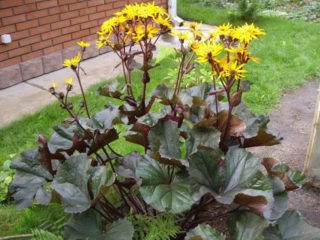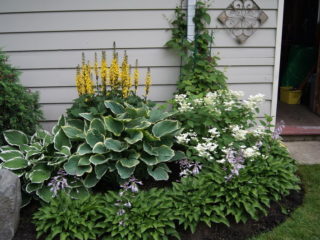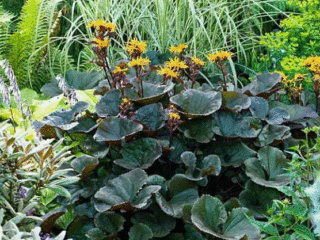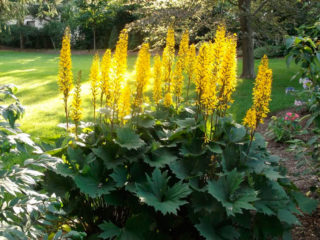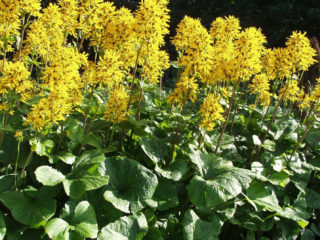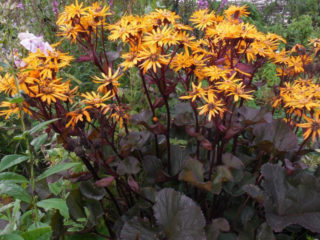Content
Ligularia Black Purple, or jagged buzulnik, is an ideal choice for shady areas of the garden. An unpretentious perennial of the Astrov family requires a minimum of care, while blooming non-stop throughout the summer. In landscape design, powerful and picturesque ligularia Black Purple bushes are used to decorate artificial reservoirs, the background of prefabricated floral compositions, as a phyto-solitaire, and a camouflage element for various architectural objects.
In its natural habitat, the jagged buzulnik (Ligularia dentata) grows in the mountainous and foothill regions of the Asian countries of Europe and North America.
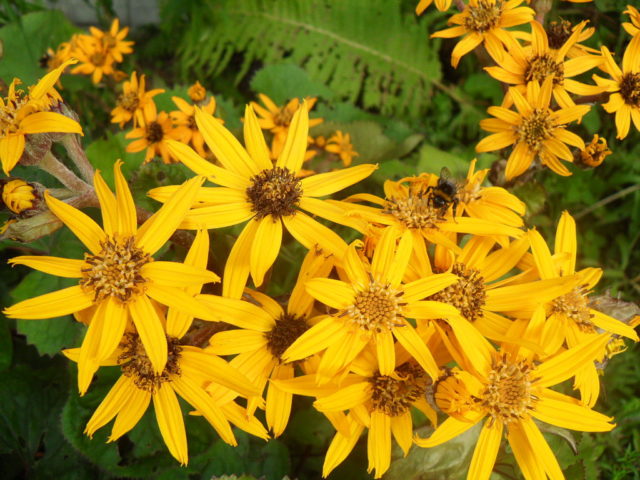
Buzulnik jagged variety Black purple is a stress-resistant plant characterized by simple agricultural technology
Description of Serrated Ligularia Black Purple
Toothed Ligularia Black Purple is one of the most delightful ornamental varieties. A powerful, cold-resistant bush of buzulnik Black purple proudly rises above low-growing crops and blooms sunny for a long time.
The plant is characterized by the following characteristics:
- stems erect, up to 1 m high;
- stem color greenish-brown;
- petioles are tall, collected in a rosette from the root;
- petiole size up to 60 cm;
- the shape of the leaf blades is semicircular, kidney-shaped, with marginal teeth;
- leaf size up to 40 cm;
- the color of the leaves is purple, with a black tint;
- corymbose inflorescences;
- height of peduncles up to 1 m;
- flowers are chamomile-shaped, large, in the shape of baskets;
- the color of the inflorescences is yellow;
- flower size up to 9 cm in diameter;
- The achenes are ribbed, up to 1 cm long.
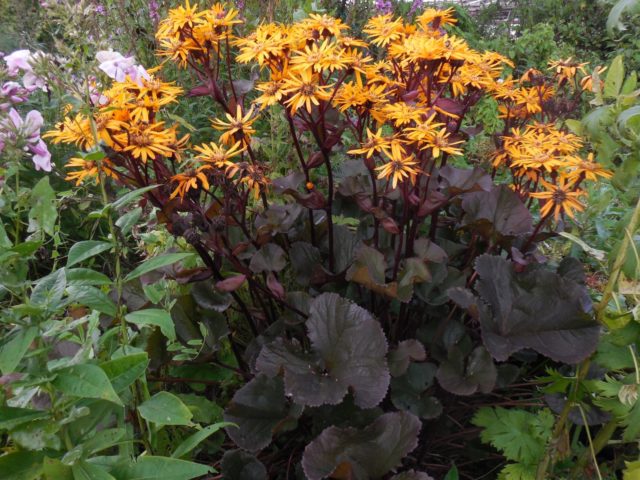
Flowering of Ligularia serrata Black Purple begins at the end of July and ends at the end of September
Application in landscape design
Ligularia serrata Black purple is a luxurious decorative variety that has gained popularity among landscape designers. The culture amazes with the beauty of its foliage, the longevity and durability of its inflorescences, and its ability to grow in the shade of buildings and trees without losing its decorative characteristics.
The plant is successfully used as dominant elements:
- prefabricated flower beds, flower beds, mixborders;
- for decorating and masking defects in house walls, fences, and other architectural forms;
- for decoration of artificial ponds and reservoirs.
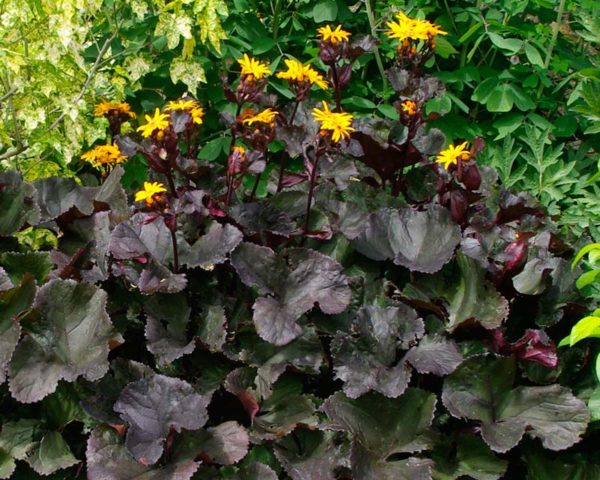
Ligularia serrata Black purple tolerates shade and excess moisture well and requires minimal care
Features of reproduction
Decorative ligularia Black purple is propagated in two main ways:
- vegetative;
- seed.
Vegetative propagation allows you to rejuvenate the plant, increase the size of the leaf blades, and increase the intensity and brightness of the color of the leaves. Such propagation methods for Ligularia Black Purple include:
- rhizome division;
- division of root suckers;
- planting cuttings.
New seedlings begin to bloom the following year, and mother plants significantly increase their foliage mass.
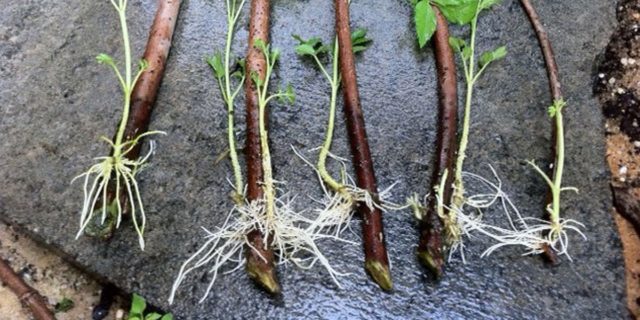
Separation of stronger shoots for propagation by layering and division of the root system is carried out in the spring
Seed propagation involves planting seeds in open ground. Since they need stratification, sowing is done in late autumn. In addition, seedlings can be forced. Sowing of seeds is carried out in February-March.
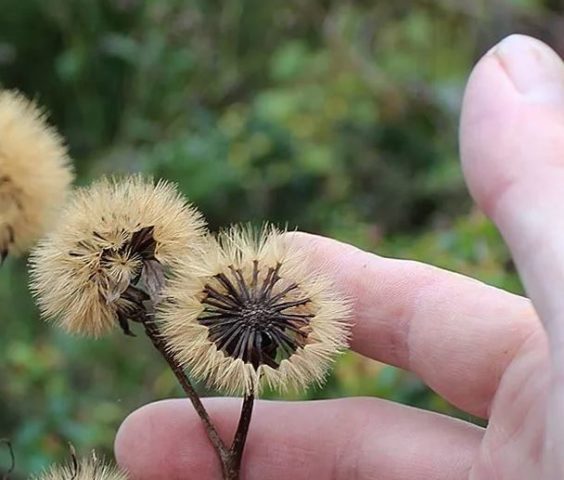
Seed material is pre-stratified in the refrigerator for 1 month
Planting and care
Ligularia Black Purple does not require special, delicate care. For plants, it is enough to follow the correct agricultural techniques for planting in the ground and carry out universal care measures: watering, fertilizing, loosening and mulching the soil, pruning, preparing for winter.
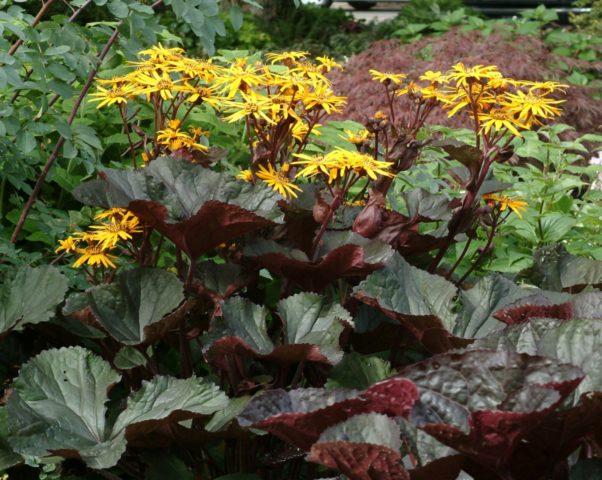
Basic care for a buzulnik does not take much time
Recommended timing
During vegetative propagation in the spring, after the mother bushes awaken, the rhizomes are separated and healthy shoots are separated for rooting of the cuttings.
When propagating by seed at the end of May, after the soil has warmed up and a stable temperature has been established during the day, the seedlings are transplanted into open ground (in the case of sowing seeds for seedlings). Buzulnik seeds are sown for seedlings at the end of February or at the beginning of March.
You can sow the seeds of Ligularia Black Purple directly into open ground at the end of November, before the onset of the first frost.
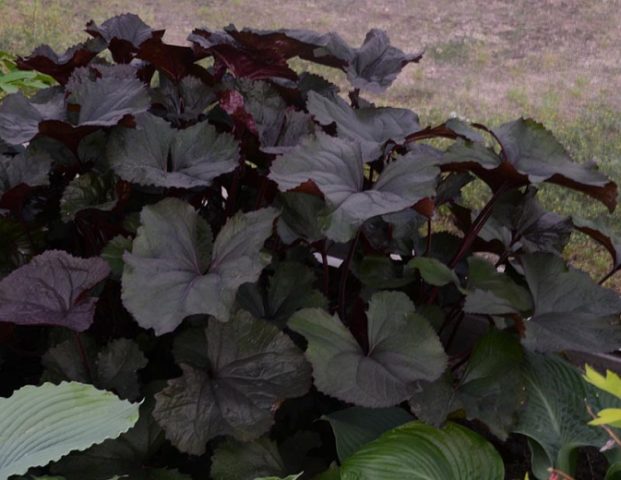
Plants planted in the ground in the spring quickly adapt to their new “place of residence”
Site selection and soil preparation
Fertile, loose, moist soil with a low sand content is most preferable for serrated type ligularia Black purple. Loamy soils in lowland areas are the best option for planting the crop. Direct sunlight is destructive for buzulnik, so it is best to plant bushes in shady places, lowlands, under tree canopies, and on the shoreline of artificial reservoirs.
To transplant bushes, it is necessary to prepare shallow holes, the surface of which is filled with drainage, as well as a mixture of humus and clay soil.
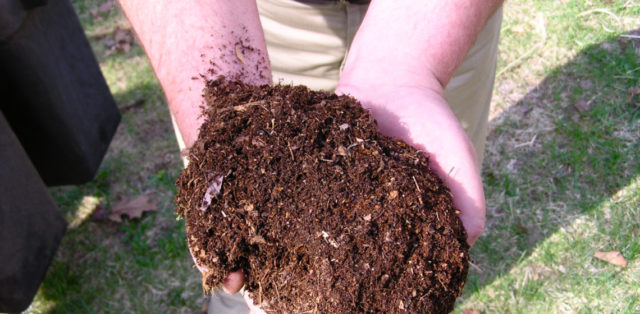
Before transplanting the bushes, the holes are thoroughly moistened with water.
Landing algorithm
Algorithm for planting buzulnik when dividing rhizomes or root suckers:
- in the spring, the mother plant is dug up along with a lump of earth;
- With a sharp shovel, a part of the root system containing several (2-3) viable buds is separated;
- root sections are treated with a weak solution of potassium permanganate and sprinkled with wood ash;
- New seedlings, together with a lump of earth, are moved to a new place, observing a planting pattern of 100x80 cm.
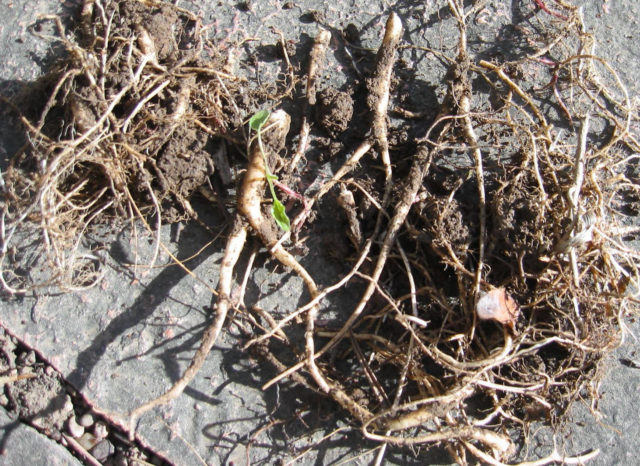
For propagation, it is good to use young root branches; it is better not to plant old ones.
Algorithm for planting serrated type ligularia Black purple with seeds:
- in February, the seeds are stratified for 1 month in the vegetable drawer of the refrigerator or outside;
- in March, the seeds are sown in a seedling box, watered abundantly and provide a greenhouse effect;
- after the emergence of seedlings, the shelter is hidden, and the seedlings are provided with moderate watering;
- at the end of May, when consistently warm weather sets in, the seedlings are planted in open ground at a distance of up to 1 m between individual bushes and watered abundantly.

Before transplanting ligularia seedlings into open ground, young plants are hardened for 1-2 weeks
Watering and fertilizing schedule
Since the jagged type ligularia Black Purple is distinguished by its impressive bush size and significant foliage area, the plants intensively evaporate natural moisture, and therefore require constant soil moisture. Watering is done in the evening or early in the morning to prevent burns on the leaves.
When transplanting buzulnik bushes into soil well fertilized with humus, the plants do not need feeding for the first two years. The brightness of the color of the leaves and the intensity of flowering depend on the degree of soil fertility. The plant “prefers” natural nutrition in the form of mullein and humus. The bushes should be fed with mullein infusion mixed with superphosphate and wood ash 2-3 times during the summer season. Fertilizer is applied at the root, avoiding contact of fertilizers with the foliage.
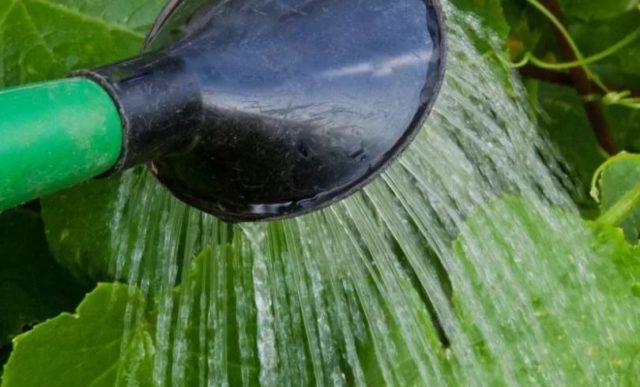
Plants should be fertilized several hours after heavy watering to prevent burns.
Loosening and mulching
To preserve natural moisture for a longer period of time, the bushes of ligularia serrated type Black purple can be mulched with dry hay or grass, last year's leaves or humus.
Intensive weeding is carried out in the spring during the period of plant growth. In the summer, the increased volume of foliage “clogs” weeds, and there is no need for weeding.

It is recommended to loosen the soil periodically while watering plants.
Trimming
After flowering ends, the flower stalks with dry inflorescences are cut off. Ligularia bushes look more aesthetically pleasing with well-groomed inflorescences.

Trim dry flower stalks to ground level
Preparing for winter
The foliage on the buzulnik is left over winter and not cut off. After wilting, the foliage provides natural cover for the root system, which allows plants to more comfortably survive frosts. In regions with harsher winters, you can mulch plants with leaves or branches.
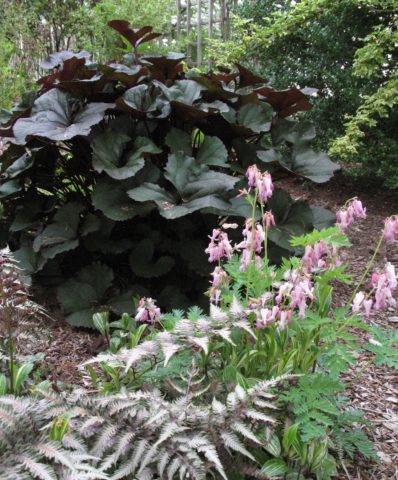
In spring, the shelter is removed, last year's leaves are cut off in such a way as not to harm viable buds.
Diseases and pests
Ligularia variety Black Purple is a plant with stable immunity. In rare cases, plants may be affected by powdery mildew.
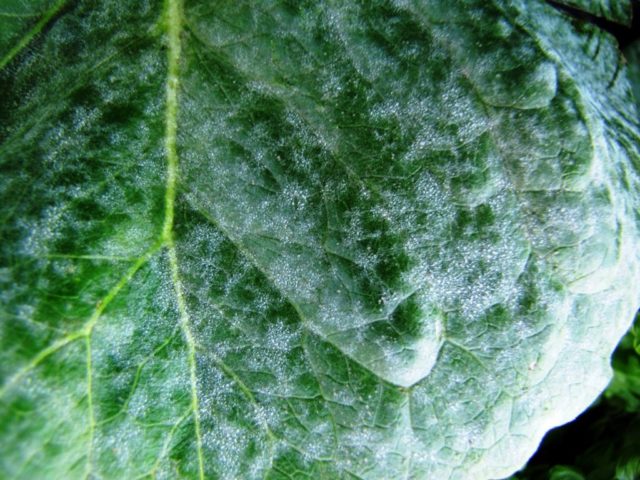
Modern fungicides are used to treat powdery mildew
One of the most common pests that attack buzulnik are slugs. In the immediate vicinity of water bodies, they necessarily settle on extensive ligularia bushes in order to gnaw unaesthetic and large holes. There are many ways to combat slugs:
- pests can be collected manually;
- You can make grooves near the bushes, which should be filled with wood ash, river sand and tobacco;
- The soil around the plants can be sprinkled with superphosphate.
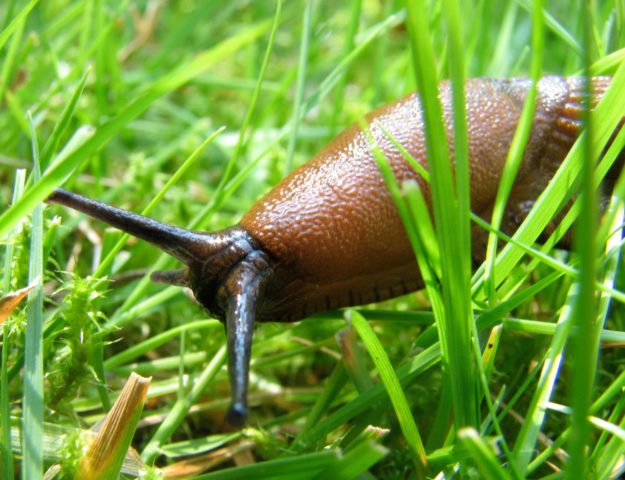
It is imperative to inspect buzulnik bushes for slugs in the spring, when the leaves are young, juicy and tender.
Conclusion
Buzulnik, or Ligularia Black Purple, is an unpretentious, moisture-loving and shade-loving, beautiful ornamental plant. Yellow inflorescences illuminate the most shaded areas of the garden with rays of sunlight from chamomile-like flowers from July to late autumn. Black broad leaves with a rich purple tint resemble a thick, continuous, glossy carpet.
